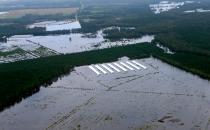Spraying animal waste is bad, and worse before a hurricane
As coastal communities along the Outer Banks and beyond continue to rebuild after the destruction wrought by Hurricane Dorian, there’s an additional worry on the minds of folks living in rural North Carolina: the spraying of untreated hog waste before and after major weather events, as well as the threat of spills of untreated hog waste into nearby rivers and streams, also during and after major rainfall.
NC Policy Watch environmental reporter Lisa Sorg was headed to the coast to cover the hurricane on September 3, when she tweeted, “parts of I-40 are particularly acrid & pungent.” She noted the stench was likely a result of nearby hog farmers pumping down their lagoons and spraying untreated hog urine and feces on their land and into the air before the storm’s arrival, in an attempt to avoid overflowing in the coming storm.
Spraying untreated hog waste onto already-saturated fields after a major storm also increases the risk of polluting waterways and downstream communities. SELC attorney Blakely Hildebrand, joined by half a dozen partners, submitted a letter to the North Carolina Department of Agriculture and Consumer Services last October, in the middle of the 2018 hurricane season, calling for the prohibition of this practice—but the agency didn’t respond.
“This practice adds insult to injury for communities and the environment, which are already suffering the adverse effects of major rain events,” says Hildebrand.
Hog waste lagoons, which are open pits containing untreated feces and urine, are very vulnerable to flooding during these major rain events. In fact, last September, after the Wilmington area received approximately 30 inches of rain during Hurricane Florence, operators at a number of industrial hog facilities reported that at least six of their hog waste lagoons experienced structural damage, 32 lagoons experienced discharges or other spills, and nine lagoons were inundated.
At that time, more than 2.2 million gallons of waste were believed to have been released from just one of the lagoons in Duplin County. Numerous other poultry waste piles were likely swept up in the floodwaters, also getting swept into the environment and nearby communities.
Following these types of releases, sampling shows high levels of nutrients and fecal bacteria in waters across eastern North Carolina, posting a threat to both human health and rebuilding efforts. Some of the most common contaminants and pathogens associated with industrially farmed animal manure include E. coli, salmonella, nitrogen, phosphorous, pesticides, and hormones.
SELC will be monitoring the issue as the 2019 hurricane season continues.

